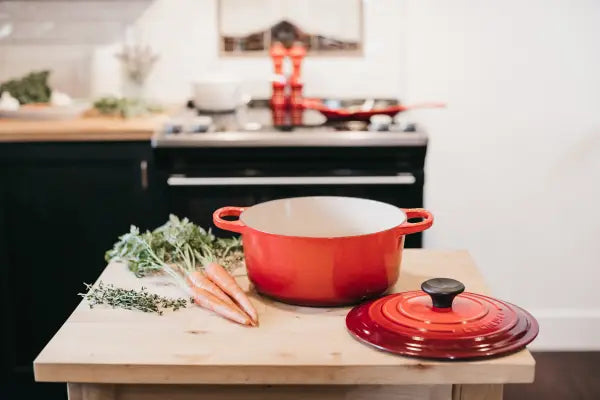What’s in Season? Making Baby Purees with Spring Fruits and Veggies

Springtime is a magical season filled with bright, sunny days, blooming flowers, and wildlife emerging from winter’s lull. It’s also a wonderful time to introduce your baby to solid foods, as many fruits and vegetables are at their peak flavor. You may be wondering how to incorporate seasonal foods into your baby's meals.
What does it mean to eat seasonally? And why it matters for baby food purees
Eating seasonally means choosing foods that are naturally available and harvested during their growing season. This typically includes fruits and vegetables, but sometimes also certain fish or meats.There are several benefits to eating seasonally: not only is produce fresher (so it lasts longer), but it also tends to be higher in nutrients and more flavorful than off-season alternatives.
The benefits don’t stop there—seasonal produce is often less expensive and better for the environment. Especially when sourced locally, seasonal eating supports farmers, reduces transportation emissions, and minimizes the resources needed for storage.
Feeding your baby while taking small steps to protect their future? That’s a win-win! You can dive deeper into why local and organic matter for little ones in our dedicated article.
Benefits of seasonal fruits and vegetables for baby purees
-
Produce is fresher, more flavorful, and more nutrient-dense
-
Seasonal options are more affordable and eco-friendly
-
Supports local farmers and reduces transportation emissions
What Spring produce can you use in baby purees?
What fruits and vegetables are in season in Spring?
Spring produce varies by location but commonly includes:
-
Strawberries
-
Peas
-
Asparagus
-
Collard greens
-
Herbs
-
Mangoes
-
Radishes
-
Parsnips
-
Spinach

Where to buy seasonal fruits and vegetables for baby food?
-
Farmers' Markets: Great for fresh finds and baby-friendly outings
One of the best ways to discover what’s in season near you is by visiting local farmers' markets. Farmers have extensive knowledge of what’s fresh and often share their favorite ways to prepare what they grow. Plus, markets are a fun experience for babies and children—filled with vibrant colors, lively energy, and a sense of community. -
Grocery Stores: Look for labeled “seasonal” or “local” picks
If a farmers' market isn’t an option, check your grocery store. Seasonal produce is often abundant and more affordable. Some stores highlight locally farm-sourced items, making it easier to shop seasonally. -
CSA Programs: Weekly deliveries of just-harvested produce
Another great option is Community Supported Agriculture (CSA). A CSA subscription provides a weekly share of freshly harvested produce—often the freshest you can get, aside from growing it yourself!
For more guidance, check out the USDA Seasonal Produce Guide.
Nutritional benefits of using Spring produce in baby purees
Strawberries
-
Rich in vitamin C, folate, and fiber
-
Supports wound healing and a strong immune system
Peas
-
Naturally sweet and packed with protein, fiber, vitamin C, and magnesium
-
Supports muscle function and growth
Asparagus
-
High in potassium and vitamin K
-
Promotes strong bones and heart health
Spinach
-
Nutrient-dense with iron, lutein, and vitamin A
-
Supports red blood cell production and vision
Parsnips
-
Loaded with vitamin C, K, fiber, and folate
-
Great source of healthy carbohydrates for energy

How to incorporate Spring fruits and vegetables into baby food purees
Purees made with peas
-
Boil peas until soft, then blend them with water until smooth
-
Enhance the flavor by adding finely chopped mint or a drizzle of olive oil with a squeeze of lemon or a little pesto
-
For older babies and toddlers, try peas with pasta
Fresh herbs and greens in baby purees
Mix finely chopped dill into carrot puree
-
Blend parsley into potato puree
-
Sprinkle cilantro into an avocado puree
-
Herbs and greens are also good in eggs. Pair sautéed spinach with eggs or sprinkle chives into an egg omelet.
Using strawberries for fruit purees
-
Mash or blend strawberries with breast milk or formula for new eaters
-
Chop for older babies to eat on their own or mix into purées
-
Combine pureed strawberries with whole-fat yogurt for a creamy snack
Psst—need inspiration for strawberries? This strawberry & rhubarb smoothie is a favorite around here.
Pureed vegetables: Asparagus for babies
-
Steam or roast until soft, then purée
-
Mix with crème fraîche for a creamy velouté
-
Let older babies self-feed with soft spears
Parsnip baby food purees
-
Steam or roast until soft, then purée
-
Serve it on its own or transform it into a soup by thinning it with low-sodium vegetable or chicken broth. Mix in cooked leeks or garlic to enhance the flavor.
-
For older babies, parsnips can be steamed or roasted and diced (but avoid hard coin-shaped pieces with are a choking hazard)
Can I use frozen fruits and vegetables in baby purees?
Absolutely. Research suggests frozen fruits and vegetables can be even more nutritious than produce stored for several days. Whether fresh or frozen, both deliver the nutrients your baby needs.
You’re doing great! Feeding your baby with confidence, one spring puree at a time
Whether you're preparing baby food from scratch or using pre-made options, introducing seasonal fruits and vegetables through purees is a great way to support your baby's development.
Most importantly, enjoy this exciting phase of your baby’s development. Give yourself credit for exploring ways to introduce variety into their diet.
If you're looking for more recipe ideas and expert-backed guidance tailored to your baby’s food journey, check out our Bébé Foodie app!

Written by Catharine Seiler RD
Pediatric Dietitian & Advisor at Bébé Foodie
Catharine Seiler is a pediatric dietitian with over 14 years of experience in both clinical and outpatient settings. She’s worked at Boston Children’s Hospital and now supports families daily at Lexington Pediatrics. At Bébé Foodie, Catharine lends her expertise to help parents feel confident about nutrition—from growth concerns to picky eating and food allergies. As a mom of two, she brings both professional insight and a real-life understanding of what feeding kids actually looks like.


Leave a comment